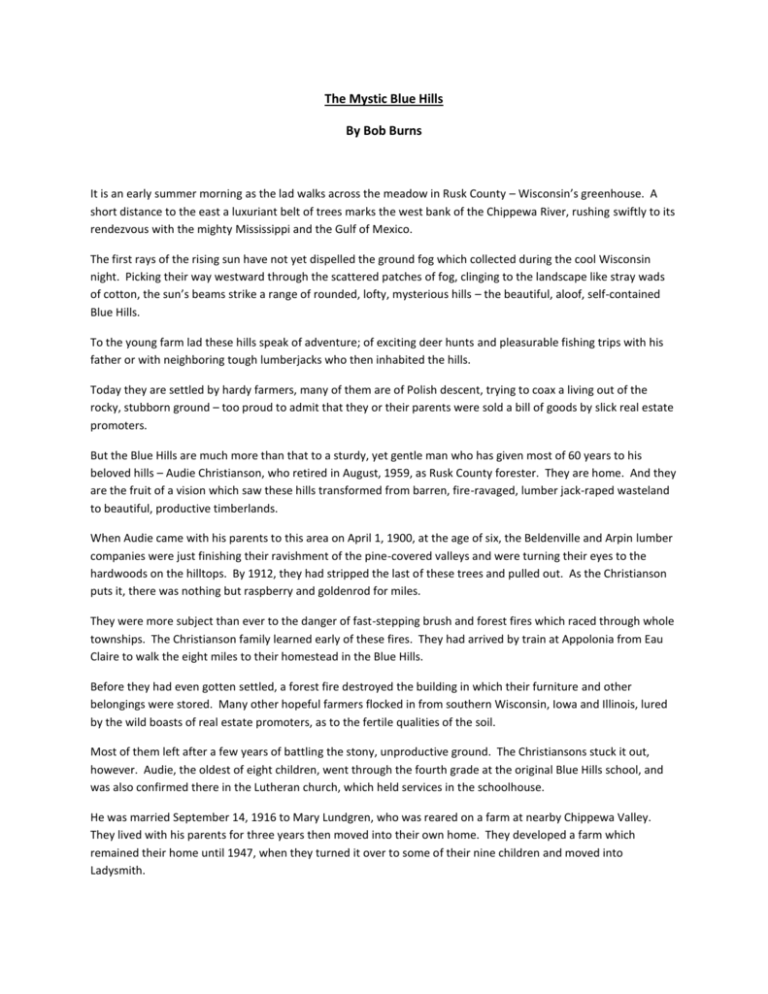The Mystic Blue Hills by Bob Burns (1)
advertisement

The Mystic Blue Hills By Bob Burns It is an early summer morning as the lad walks across the meadow in Rusk County – Wisconsin’s greenhouse. A short distance to the east a luxuriant belt of trees marks the west bank of the Chippewa River, rushing swiftly to its rendezvous with the mighty Mississippi and the Gulf of Mexico. The first rays of the rising sun have not yet dispelled the ground fog which collected during the cool Wisconsin night. Picking their way westward through the scattered patches of fog, clinging to the landscape like stray wads of cotton, the sun’s beams strike a range of rounded, lofty, mysterious hills – the beautiful, aloof, self-contained Blue Hills. To the young farm lad these hills speak of adventure; of exciting deer hunts and pleasurable fishing trips with his father or with neighboring tough lumberjacks who then inhabited the hills. Today they are settled by hardy farmers, many of them are of Polish descent, trying to coax a living out of the rocky, stubborn ground – too proud to admit that they or their parents were sold a bill of goods by slick real estate promoters. But the Blue Hills are much more than that to a sturdy, yet gentle man who has given most of 60 years to his beloved hills – Audie Christianson, who retired in August, 1959, as Rusk County forester. They are home. And they are the fruit of a vision which saw these hills transformed from barren, fire-ravaged, lumber jack-raped wasteland to beautiful, productive timberlands. When Audie came with his parents to this area on April 1, 1900, at the age of six, the Beldenville and Arpin lumber companies were just finishing their ravishment of the pine-covered valleys and were turning their eyes to the hardwoods on the hilltops. By 1912, they had stripped the last of these trees and pulled out. As the Christianson puts it, there was nothing but raspberry and goldenrod for miles. They were more subject than ever to the danger of fast-stepping brush and forest fires which raced through whole townships. The Christianson family learned early of these fires. They had arrived by train at Appolonia from Eau Claire to walk the eight miles to their homestead in the Blue Hills. Before they had even gotten settled, a forest fire destroyed the building in which their furniture and other belongings were stored. Many other hopeful farmers flocked in from southern Wisconsin, Iowa and Illinois, lured by the wild boasts of real estate promoters, as to the fertile qualities of the soil. Most of them left after a few years of battling the stony, unproductive ground. The Christiansons stuck it out, however. Audie, the oldest of eight children, went through the fourth grade at the original Blue Hills school, and was also confirmed there in the Lutheran church, which held services in the schoolhouse. He was married September 14, 1916 to Mary Lundgren, who was reared on a farm at nearby Chippewa Valley. They lived with his parents for three years then moved into their own home. They developed a farm which remained their home until 1947, when they turned it over to some of their nine children and moved into Ladysmith. Fire was a constant enemy of the Blue Hills residents until the state fire protection service was organized in the late 1920’s. About this same time, lumbermen began to see the wisdom of reforestation to protect their supply of timber and to insure a continuing crop. This became Christianson’s theme, both on his farm and when he became county forester in the fall of 1942. The results of this conservation program may be seen today by the motorist who travels the winding roads of the Blue Hills, often beneath great, green arches of the trees which have flourished with the help of wiser humans. To the lover of beauty, the best reward is on a crisp, sunny autumn morning, when the aspen and maple splash the hills with scarlet and yellow, framed by the white birch and softened by the modest oak. Blue Hills Geological History The Woodland Sioux may have called them Paja Toyela-Blue Hills long before the first white men set their eyes on them. These ancient highlands lay within a half hour’s drive West of Ladysmith. As in prehistoric times, these wooded hills team with plant and animal wildlife of all kinds of native to the northwest section of Wisconsin. The quartzite and metasandstones, which make up the rock substance of the Blue Hills outcrop originated in that part of geologic time called the Precambrian. As presently understood, in between the time that the lofty Penokean Range thrust its mountain summits into the skies of what is now northern Wisconsin and Upper Michigan some 1.6 billion years ago and the intrusion of the granites of the Wolf River Batholith to its southeast some 100 million years later, a vast thick sheet of sediments, sand and muds washed down were folded and eroded over a long period of time with the end result of reducing the Precambrian of Wisconsin to a nearly flat plain. However, in a few places, isolated remnants of this sheet of sediments were left, forming isolated hills called monadnocks. The Blue Hills are one such monadnock. The Blue Hills was once a gigantic mountain range located in the northwestern part of Rusk County. These hills outdate the popular Rocky Mountains as well as the Appalachian range. Geologists have estimated that the Blue Hills were once part of a mountain range some 20,000 feet high. The peaks were rounded off by successive ice masses, and the last of the massive glaciers stopped at the very foot of these hills. Covering over 23,000 acres in Rusk County, these hills now provide enjoyment for hikers, cyclists, skiers, cross-country skiers, horseback riders, and snowmobilers. A favorite with hunters, the wild terrain provides a refuge for deer, rabbits, squirrels, and birds of all kinds. Rustic camping areas are found near Perch and Audie Lakes, and Murphy Flowage. Trout fishing is at its finest in several of the streams. Where once the hills were covered with pine forests, now the hardwoods have taken over, and Autumn color is spectacular. Whatever your favorite activity, it can be found in the beautiful Blue Hills.







